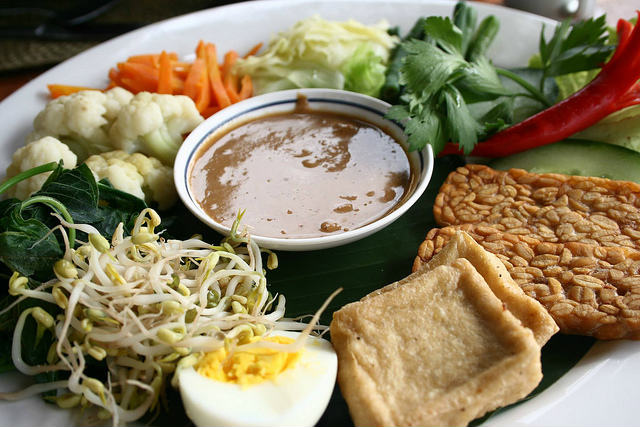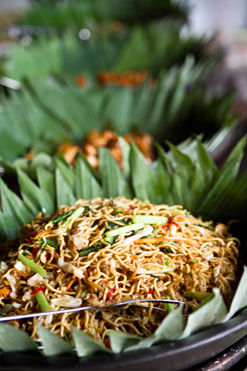Is It Easy to Eat Vegetarian in Bali
Indonesia is not often thought of as a vegetarian's paradise, which is a shame because one may find lots of choices here, especially in Bali. It may be true that Indonesians like meat, and especially fish, but it is also true that meat in Indonesia can be quite expensive. As such, an Indonesian's everyday diet is most likely to be rice with meat used sparingly as an accompaniment, as well as a range of vegetable dishes that not only deliver punchy flavours but also boost the nutritional value.
Moreover, with the popularity of tourism in Bali, there are also more international vegetarian dishes to choose from here. But I would suggest giving local vegetarian food a try, and you will be delighted. You'll be surprised by the vegetarian choices you can find here in Bali or anywhere in Indonesia. Here are some of the best Indonesian vegetarian dishes that I recommend:
Gado-gado
Indonesian food is (sadly) not a very popular cuisine, but if people can name any dishes found here, then they usually mention Indonesia's most famous salad, Gado-gado. It is a dish of vegetables that usually includes lettuce, cabbage leaves, steamed carrots and potatoes, and often tofu and bean sprouts. The whole thing is then drenched in a thick and delicious peanut sauce and is often topped with extras like egg or prawn crackers. If you avoid these crackers, however, then the entire dish is vegetarian, and in Indonesia's heat, this salad is a welcome break from yet another plate of steaming rice. IT can be found in just about any local restaurants or warungs in Bali.

Gado-gado, a vegetarian's favourite in Bali and rest of Indonesia. Fried Tempe on the bottom right. Photo by eltpics
Tempe Goreng/Sambal
Tempeh is probably the grande dame of vegan and vegetarian food in Bali and Indonesia, evolved as a cheap way of adding protein to a meal. Tempeh is essentially soybeans that have been compressed into the shape of a bar, which is then sliced into strips and fried until it darkens, and the flavour becomes deliciously nutty. Tempeh is so tasty that it is sometimes fried until crisp and then served that way (tempe goreng), or it is often fried with chilli paste to give it some kick (tempe balado or tempe sambal).
Nasi Padang
Nasi Padang means 'Padang rice' as it originated in the Padang area of West Sumatra. You will spot a Padang restaurant (all over Bali and Indonesia) due to the distinct stacked plates in the window. Once inside, you will be served a plate of white rice and a selection of smaller dishes (sometimes as many as 20) will be brought to your table. You just choose what you want to eat and ignore the rest. For vegetarians, therefore, this is a dream scenario as you can easily spot and avoid meat and stick to the wide range of vegetarian options available. Some of the veggie highlights of a Padang restaurant are dishes such as daun singkong, which are cooked cassava leaves as well as other items like telur balado, hard-boiled eggs that have been coated with fried chilli paste. Other favourites are eggplant (terong) cooked until it is falling apart and also mixed with chilli paste or potato cakes called perkedel. Tahu (tofu) is also common and is served in large blocks and is usually fried.
Sayur Asem
Sayur asem translates as 'Sour Vegetables' and in this way this dish is slightly reminiscent of something like Tom Yam soup in Thailand. The sourness in this soup comes from tamarind, and you will usually find veggies like snake beans, corn, and melinjo (a local plant). The soup is served over rice and is entirely meat-free, so is a safe one for both vegetarians and vegans alike. This can also easily be found in Bali restaurants, especially those where you order dishes to go with your rice.
Sayur Lodeh
A firm favourite in Indonesia is sayur lodeh, a coconut milk based soup that uses gourd and carrot to add some heartiness and is served with rice. Other additions can be things like tofu depending on who is making it, or sometimes other vegetables will be added into the mix as well. In some varieties of sayur lodeh (like in Sumatra) small shrimps are usually used to enhance the flavour, but the Javanese and Balinese version usually makes it without which means that it will be vegetarian.
Nasi Goreng
Perhaps Bali's and even so Indonesia's best-known dish would be nasi goreng. This dish is simply a plate of fried rice with various things added to it to make it more exciting. You can, in theory, cook nasi goreng with pretty much anything and you will find it with meat, fish, and seafood in it, although in its purest form it is simply made of fried rice with some vegetables like carrots added to it and topped with a fried egg. If you ask for it to be made 'tanpa daging' (without meat) then this is usually what you will get and it will be safe for vegetarians. Just watch out for the toppings as it is often sprinkled with peanuts and small salted anchovies (ikan teri). If you don't eat fish or seafood then ask for it to be 'tanpa daging dan tanpa ikan' (without meat OR fish).

Indonesian Nasi Goreng, Bali. Photo by RStacker
Mie Goreng

Indonesian Mie Goreng, Bali. Photo by suhseal, cropped to Mie Goreng
Mie goreng is the partner of nasi goreng but where 'nasi' means rice and 'goreng' means fried, 'mie' refers to the noodles in this dish. It is the next most popular one dish meal in Bali and Indonesia. Mie goreng or fried noodles is a vague name because the dish itself is also rather vague and it can be made with a variety of different noodles and with a range of things mixed in depending on what the cook has to hand. In its purest form again, however, it will be meat and seafood free, so 'tanpa daging dan ikan' should ensure that you get a plate of steaming fried noodles with fresh crunchy veggies, and sometimes an egg scrambled in.
Rujak
If you are not used to it, then rujak can be a strange concept. It is a fruit and vegetable salad that is served with a thick sauce made of chilli and peanuts and it can be something of an acquired taste. Each part of Indonesia appears to make rujak differently, but some things that you might find in it include water apple, raw unripe mango, pineapple, cucumber, or sweet potato. In Bali, the rujak is sweet and sour with a mix of fruits. This mix is then doused with a savoury sauce, which is often cooked down to a glutinous consistency that can be almost like toffee. Sometimes the sauce will use small amounts of terasi, which is a shrimp paste, so if you want to check, you can ask 'Pakai terasi?' ('Does it have terasi in it?'). If you get a 'no' then you are good to go, and it will be vegetarian and vegan. Rujak is often eaten more as a snack than as part of the main meal, and you will find it sold from many a cart or small stall at the side of the road.

Rujak in Bali, Indonesia Food. Photo by Sue
Indonesian food should better known, as there is a vast amount of variety on offer here, and much of it features diverse, complex flavours that are simply delicious. Indonesians unashamedly love meat, fish, and seafood, and vegetarianism is uncommon here. Still, if you pick and choose, you will find a vast range of fresh, tasty vegetarian and vegan dishes in between the meat curries and barbecued seafood anywhere in Indonesia and more so in Bali. Do let us know if you know more vegetarian food in Bali and Indonesia!
Related articles:
Top 10 Indonesian Food You Must Eat
Top 10 Restaurants in Bali
Top 6 Local Warungs to Eat in Sanur, Bali
Source: https://allindonesiatravel.com/top-vegetarian-food-eat-bali-indonesia/
Post a Comment for "Is It Easy to Eat Vegetarian in Bali"